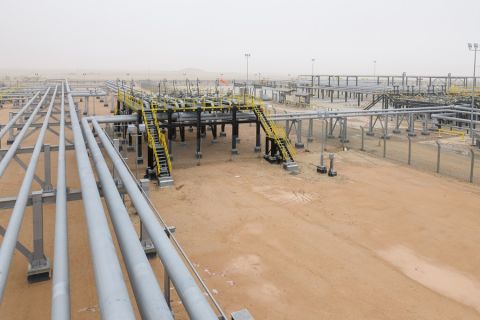The prodigious amount of crude being developed in U.S. shale formations means more domestic product can be used at home, but criticism of Jones Act restrictions on shipping is resurfacing as that domestic oil is delivered to meet demand.
The law—passed as part of the Merchant Marine Act of 1920—stipulates that only vessels crafted and crewed by U.S. workers may move commodities from one domestic port to another. It was born of national security concerns as well as federal cherry-picking that protected the nation’s shipping industry.
Periodically, questions arise about its necessity in the modern world, especially when economics come into play.
In December, ExxonMobil chartered the U.S. flagged American Phoenix oil tanker on a one-year lease for a jaw-dropping $100,000 per day. Previous day rates for a vessel the size of Phoenix—which has a cargo capacity of about 339,000 barrels (bbl.)—were closer to $70,000 per day.
“You can argue about the necessity of this law as it relates to maintaining domestic shipping capability for national security, but you can’t argue about the economic outcome, which is that it raises rates artificially,” Ethan Bellamy, senior analyst at Robert W. Baird & Co. in Denver, tells Midstream Business.
“The Jones Act is a supercharger when you bolt it onto the crude oil export ban,” Bellamy says. “The feds constrain the crude oil market by curtailing exports, then further limit the ability to move crude oil by reducing the number of vessels that can carry crude between U.S. ports. If you believe in free markets, this looks truly Kafkaesque. Nevertheless, this is the landscape in which producers and logistics firms must operate.”
As such, there’s a lot of money to be invested in the midstream sector now, and many companies are looking to buy infrastructure, Sandy Fielden, director of energy analytics at RBN Energy LLC in Austin, tells Midstream Business.
“Jones Act vessels are definitely a good bet right now,” he says. “But it seems like no one's going to build a new shipyard because of the crude boom—that is too risky. As a result, capacity will remain tight, and I presume the shipbuilders can charge what the market will bear.”
A rising tide
Primarily from the Bakken, Eagle Ford and Permian basin regions, the U.S. Energy Information Administration (EIA) expects oil production to continue to increase through 2015. Production estimates for 2013 showed 7.4 million bbl. per day to projected 8.4 million bbl. per day and reaching 9.2 million bbl. per day in 2015.
Production from these three plays is positioned to access Jones Act vessels, with the Bakken crude traveling by rail to Oregon and Washington, and then shipped to Los Angeles and San Francisco refineries. Crude from the Eagle Ford and Permian basin can reach domestic markets via the Port of Corpus Christi, Texas.
Tanker transport of crude from the Gulf Coast to the Northeast via maritime routes has increased exponentially from almost 4 million bbl. in 2010 to more than 34 million bbl. in 2013, according to information from the EIA.
Leadership at Kinder Morgan Energy Partners has jumped on the need for more Jones Act crude delivery. In December, the Houston master limited partnership announced its plan to buy five medium-range Jones Act tankers, each with a cargo capacity of 330,000 bbl. As part of the $962 million agreement, Kinder now has commissioned the construction of four medium-range tankers scheduled for delivery in 2015 and 2016.
Several issues will drive demand for Jones Act tankers, Richard Kinder, Kinder Morgan chief executive, explained during a fourth-quarter conference call with analysts.
Bakken crude presents one potential growth stream, he said. Also, industry experts believe production in Texas’ Eagle Ford and Permian basin will result in crude being shipped eventually through the Panama Canal and back up to California. Plus, the Colonial Pipeline in the Northeast—a lifeline of sorts along the East Coast—is close to capacity. Kinder said that could present more maritime opportunities to move refined products.
John Michael, who leads the maritime practice at Vinson & Elkins LLP (V&E), tells Midstream Business that during a seven-month period in 2013, the Houston-based law firm was directly involved in assisting clients in the acquisition of seven new-build tankers specifically designed to move crude oil from Corpus Christi to other U.S. ports.
“That is very significant when you look at the whole Jones Act fleet,” he says of the vessels, which number less than 100. “There are not a lot of vessels actively engaged in this trade.”
Just a few years ago, Michael notes, no crude oil traveled the outbound waters of Corpus Christi’s port; today, more than 500,000 bbl. per day depart the port for U.S. locales.
“There is sort of a renaissance now in the Jones Act shipping industry on the tanker and tank barge side that’s being driven by the huge shale plays and the explosion in U.S.-sourced crude oil,” Michael explains.
Deep pockets
In a December 2013 presentation, Valero Energy Corp. said one consequence of the Jones Act is that it costs the refining giant $2 to ship a barrel of crude to Canada, but between $5 and $6 to ship the same barrel to the East Coast.
One issue that contributes to the shortage of Jones Act vessels is the simple cost of building them. A U.S.-built tanker has a price between $100 million and $130 million, according to Poten & Partners, an energy and maritime consulting firm in New York. The cost of construction for a medium-range tanker—with capacity of 130,000 bbl. or more—at a foreign shipyard is a fraction of that price, coming in between $30 million and $40 million.
And, a Jones Act fleet has significantly higher operating expenses based on the cost of employing U.S. labor, Poten said in a September 2013 report, “Jones Act—Still the King of Rates in 2016?”
James Roussel, a senior lawyer in the New Orleans maritime practice Baker Donelson LLP, tells Midstream Business there’s no question the near century-old act raises prices.
“It’s mostly protectionist legislation for American shipowners, shipyards and American seamen. It’s a God-and- motherhood type act,” he says, adding that it’s unlikely to change.
“I really don’t think there’s much possibility the Jones Act will be repealed, at least not in my lifetime.”
Changing tides
According to Poten, 34 medium-range tankers and 42 coastal barges compose the U.S. Jones Act fleet. A dozen more are on order, and as many as 10 more could be on the way. Those vessels will add to the U.S. flag fleet during the next three to four years.
Poten warns that over-ordering could send day rates south after 2016. Although the Corpus Christi port was exporting more than 360,000 bbl. per day in August, a doubling of that amount would only require the addition of six to eight additional tankers.
Kinder said during his conference call with analysts that Jones Act tankers are key to energy infrastructure.
“We think there’s going to be increased demand,” Kinder said. “We think this is a nice place to be in. We have a good operator who’s doing the operatorship for us. So we look at this as an adjunct, another alternative in the area of transportation that we can offer our customers, and we think it’s going to pay real dividends for us. And we like the fact that we have a whole lot of this cash flow locked in, including all of the new ships being built.”
At Baird, Bellamy says there’s logic in Kinder’s decision to get into the Jones Act tanker market.
“There are only a few players who could do this, and I think Kinder is one of them,” he says, adding that the risks are significant. More ships could be built or legislative changes could happen to chop day rates in half overnight.
“It probably only makes sense to buy tankers right now as part of a much larger and diversified logistics plan, given these risks. You would need to feel comfortable absorbing these risks as part of a very large balance sheet,” Bellamy says.
Standing water
During a fourth-quarter conference call with analysts, Jim Teague, chief operating officer at Houston-based Enterprise Products Partners, mentioned Jones Act constraints during a discussion about needs in the Northeast and in the Midwest. Residents there suffered this winter during one of the coldest seasons the last 20 years.
“If you didn’t have the Jones Act,” he said, “You could’ve had this thing resolved pretty easily by moving product off the Gulf Coast in the Northeast and displacing back to the Midwest. We don’t have that in our toolbox.”
The federal government does have the ability to waive Jones Act requirements during an emergency, such as in 2012 when President Obama scrapped the rule to move gasoline to Hurricane Sandy victims.
The Jones Act Reform Coalition in Washington, D.C. and others periodically make waves to abolish or repeal the Jones Act, but the movement carries little water. And every U.S. president since Ronald Reagan in the 1980s has unequivocally endorsed it.
At V&E, Michael says restrictions in the Jones Act that require domestic ownership and operation aren’t unique.
“When you look at all the other modes of transportation out there—whether it be airlines, railroads or trucking—they all, to some extent or another, restrictions or prohibitions that require U.S. ownership or U.S. citizens to be in control,” he says. “Shipping gets singled out, but … you’re not going to take an Air Alitalia flight from Miami to Chicago.”
Deon Daugherty can be reached at ddaugherty@hartenergy.com or 713-260-1065.
Recommended Reading
ARC Resources Adds Ex-Chevron Gas Chief to Board, Tallies Divestments
2024-02-11 - Montney Shale producer ARC Resources aims to sign up to 25% of its 1.38 Bcf/d of gas output to long-term LNG contracts for higher-priced sales overseas.
Enterprise Increasing Permian NatGas Production
2024-04-03 - Enterprise Products Partners began service on two natural gas plants: the Leonidas in the Midland Basin and the Mentone 3 in the Delaware Basin, each with a capacity to process 300 MMcf/d of natural gas and 40,000 bbl/d of NGLs.
Paisie: Crude Prices Rising Faster Than Expected
2024-04-19 - Supply cuts by OPEC+, tensions in Ukraine and Gaza drive the increases.
Imperial Expects TMX to Tighten Differentials, Raise Heavy Crude Prices
2024-02-06 - Imperial Oil expects the completion of the Trans Mountain Pipeline expansion to tighten WCS and WTI light and heavy oil differentials and boost its access to more lucrative markets in 2024.
Russia Orders Companies to Cut Oil Output to Meet OPEC+ Target
2024-03-25 - Russia plans to gradually ease the export cuts and focus on only reducing output.




